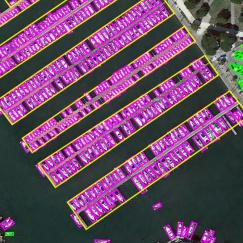Oriented Object Detection in Aerial Images Based on Area Ratio of Parallelogram
Oriented object detection is a challenging task in aerial images since the objects in aerial images are displayed in arbitrary directions and are frequently densely packed. The mainstream detectors describe rotating objects using a five-parament or eight-parament representations, which suffer from representation ambiguity for orientated object definition. In this paper, we propose a novel representation method based on area ratio of parallelogram, called ARP. Specifically, ARP regresses the minimum bounding rectangle of the oriented object and three area ratios. Three area ratios include the area ratio of a directed object to the smallest circumscribed rectangle and two parallelograms to the minimum circumscribed rectangle. It simplifies offset learning and eliminates the issue of angular periodicity or label point sequences for oriented objects. To further remedy the confusion issue of nearly horizontal objects, the area ratio between the object and its minimal circumscribed rectangle is employed to guide the selection of horizontal or oriented detection for each object. Moreover, the rotated efficient Intersection over Union (R-EIoU) loss with horizontal bounding box and three area ratios are designed to optimize the bounding box regression for rotating objects. Experimental results on remote sensing datasets, including HRSC2016, DOTA, and UCAS-AOD, show that our method achieves superior detection performance than many state-of-the-art approaches.
PDF Abstract



 DOTA
DOTA